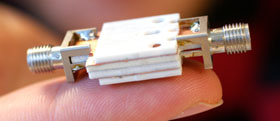New, High-Tech Microplasma Source Excites Matter in a Controlled and Efficient Way, and May Revolutionize How Archaeologists Date Objects in the Field
From the Journal: Journal of Applied Physics
WASHINGTON, D.C. Sept. 6, 2013 — A team of researchers from Uppsala University in Sweden has designed a microplasma source capable of exciting matter in a controlled, efficient way. This miniature device may find use in a wide range of applications in harsh environments, but can also help revolutionize archaeology.
As the researchers describe in the Journal of Applied Physics, produced by AIP Publishing, their new device offers many advantages, such as electromagnetic compatibility, an integrated fluidic system, and Langmuir probes for plasma diagnostics.
At the university’s Ångström Space Technology Centre (ÅSTC), the researchers work with many kinds of micro and nanotechnologies for use in space and other harsh environments: scientific instruments, imaging, communication hardware, vehicles and spacecraft, propulsion devices, and thermal management. Size limitation is always a huge challenge.
“Putting miniaturized hardware into orbit or thousands of meters underground is always technically easier and less expensive, but using fundamentally different technology for demanding applications is often met with skepticism,” explains Greger Thornell, director of ÅSTC. “So we need to also compete in terms of performance and reliability.”
The researchers are accustomed to working with microrocketry and localized phenomena in tiny devices such as sensors and actuators. These types of phenomena sometimes involve very high temperatures, intense plasma, and high pressures.
 “In this case, the localization, or rather concentration, means that the device itself becomes handy and power-efficient, and also that it consumes small sample amounts, which widens the range of applications far beyond the requirement of simply lightweight or portable instruments,” said Thornell.
“In this case, the localization, or rather concentration, means that the device itself becomes handy and power-efficient, and also that it consumes small sample amounts, which widens the range of applications far beyond the requirement of simply lightweight or portable instruments,” said Thornell.
Archaeology is one of the main applications being investigated right now to help determine the distribution of carbon isotopes in organic samples. “This information is critical for archaeologists, but measuring these isotope distributions can be extremely painstaking and time consuming,” said Anders Persson, senior researcher.
Their plasma source may be used to develop an instrument for field archaeologists, which would allow them to perform measurements while out in the field; this in turn may revolutionize archaeology by diversifying the amount of information available during the decision-making process of an excavation. “Archaeology is just one of the many exciting applications we see for our plasma source,” he added.
This is still an early study to evaluate the use of this type of plasma source in an optogalvanic spectroscopy setup. “The next step will be to start reiterating and optimizing the signal-to-noise ratios,” said Martin Berglund, doctoral student.
The Swedish National Space Board funded this research.
###
For More Information:
Jason Socrates Bardi
jbardi@aip.org
240-535-4954
@jasonbardi
Article Title
Microplasma source for optogalvanic spectroscopy of nanogram samples
Authors
Martin Berglund, Greger Thornell, and Anders Persson
Author Affiliations
Uppsala University, Ångström Space Technology Centre (ÅSTC)
